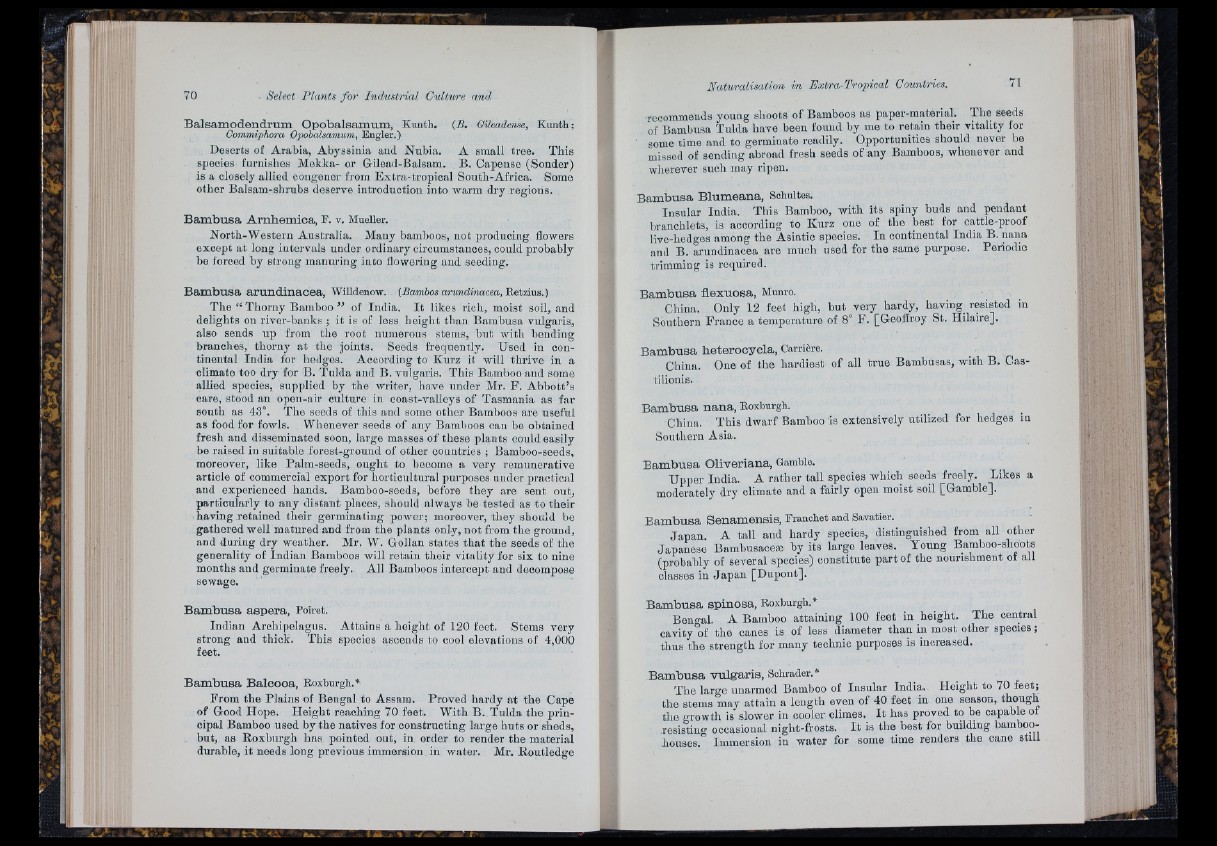
Select Plants fo r Industrial Cidture and
B a ls am o d e n d rum O p o b a ls am um , Kunth. (B, GUeadense, Kunth;
Gommiphora Opobalsamum, Engler.)
Deserts of Arabia, Abyssinia and Nubia. A small tree. This
species furnishes Meklca- or Gilead-Balsam. B. Capense (Sender)
is a closely allied congener from Extra-tropical South-Africa. Some
other Balsam-shrubs deserve introduction into warm dry regions.
B am b u s a A rn h em ic a , E. v. Mueller.
North-Western Australia. Many bamboos, not producing flowers
except at long intervals under ordinary circumstances, could probably
be forced by strong manuring into flowering and seeding.
B am b u s a a ru n d in a c e a , Willdenow. (Bambos arundinacea, Eetzius.)
The “ Thorny Bamboo ” of India. I t likes riolr, moist soil, and
delights on river-banks ; it is of less height tlian Bambusa vulgaris,
also sends up from the root numerous stems, but with bending
branches, thorny a t the joints. Seeds frequently. Used in continental
India for liedges. According to Kurz it will thrive in a
climate too dry for B. Tnlda and B. vulgaris. Tliis Bamboo and some
allied species, supplied by the writer, have under Mr. F. Abbott’s
care, stood an open-air culture in coast-valloys of Tasmania as far
south as 43°. The seeds of this and some other Bamboos are useful
as food for fowls. Whenever seeds of any Bamboos can be obtained
fresh and disseminated soon, large masses of these plants could easily
be raised in suitable forest-ground of other countries ; Baraboo-seeds,
moreover, like Palm-seeds, ought to become a very remunerative
article of commercial export for Iiorticultural purposes under practical
and experienced hands. Bainboo-seeds, before they are sent out,
particularly to any distant places, should always be tested as to their
having retained their germinating power; moreover, they should be
gathered well matured and from the plants only, not from the ground,
and during dry weather. Mr. W. Gollan states th a t the seeds of the
generality of Indian Bamboos will retain their vitality for six to nine
mouths and germinate freely. All Bamboos intercept and decompose
B am b u s a a sp e r a , Poiret.
Indian Archipelagiis. Attains a height of 120 feet. Stems very
strong and thick. This species ascends to cool elevations of 4,000
feet.
B am b u s a B a lco o a , Roxburgh.*
From the Plains of Bengal to Assam. Proved hardy a t the Cape
of Good Hope. Height reaching 70 feet. With B. Tiilda the principal
Bamboo used by the natives for constructing large huts or sheds,
but, as Roxburgh has pointed out, in order to render tlie material
durable, it needs long previous immersion in water. Mr. Routledge
recommends young shoots of Bamboos as paper-material. The seeds
of Bambusa Tulda have been found by me to retain their vitality for
some time and to germinate readily. Opportunities should never be
missed of sending abroad fresh seeds of any Bamboos, whenever and
wiierever such may ripen.
B am b u s a B lum e a n a , Schultes.
Insular India. This Bamboo, with its spiny buds and pendant
branchlets, is according to Kurz one of the best for cattle-proof
live-hedges among the Asiatic species. In continental India B. nana
and B. arundinacea are much used for the same purpose. Periodic
trimming is required.
B am b u s a fle x u o s a , Munro.
China. Only 12 feet high, but very hardy, having^ resisted in
Southern France a temperature of 8° F. [Geoffroy St. Hilaire].
B am b u s a h e te ro o y c la , Carrière.
China. One of the hardiest of all true Bambusas, with B. Cas-
tilionis.
B am b u s a n a n a , Roxburgh.
China. This dwarf Bamboo is extensively utilized for hedges in
Southern Asia.
B am b u s a O liv e ria n a , Gamble.
Upper India. A rather tall species which seeds freely. Likes a
moderately dry climate and a fairiy open moist soil [Gamble].
B am b u s a S e n am e n s is , Eranohet and Savatier.
Jap an . A tall and hardy species, distinguished from all other
Japanese Bambusacoæ by its large leaves. Young Bamboo-shoots
(probably of several species) constitute part of the nourishment of all
classes in Jap an [Dupont].
B am b u s a sp iu o s a , Roxburgh.*
Bengal. A Bamboo attaining 100 feet in height. The central
cavity of the canes is of less diameter than in most other species ;
thus the strength for many technic purposes is increased.
B am b u s a v u lg a r is , Schrader.*
Tlie large unarmed Bamboo of Insular India. Height to 70 feet;
the stems may attain a length even of 40 feet in one season, though
the growth is slower in cooler climes. I t has proved to be capable ot
resisting occasional night-frosts. I t is tlie best for building bamboo-
houses. Immersion in water for some time renders the cane still